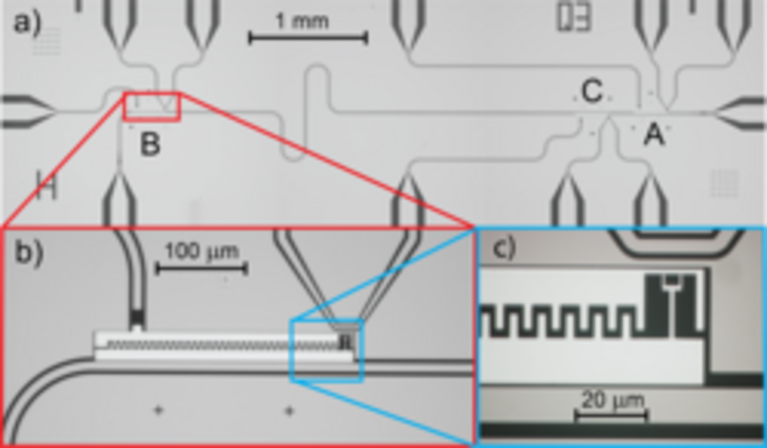January 12, 2012 - by Simone Ulmer
At the time of the Quantum Information Processing and Communication conference (QIPC) which took place at ETH Zurich last September, two publications in «Scienceexpress» appeared which were considered breakthroughs in quantum information processing. They gained high recognition at the conference. In one of the publications, a team from California implemented a quantum computing chip based on superconducting circuits.
Detect and eliminate errors
An important element of quantum information processing is the so-called Toffoli gate. It can be used to detect and correct errors that occur during the information processing. ETH-professor Andreas Wallraff and his team work with superconducting electrical circuits, as the American team does. He and his team could now realize a Toffoli gate using a chip with superconducting circuits and could verify its functionality with the newest methods. The results of the study were now published in «Nature».
Quantum information processing is susceptible to errors. Errors are, for example, caused by spontaneous emission, through which the state of a quantum bit (qubit) can change spontaneously: The excited qubit which carries the information “1” decays into the ground state and carries the information “0”. This is why data processing in quantum computers needs an error correction scheme. This task can be performed using the Toffoli gate.
In a classical computer there happens one error in about ten quadrillion (1016) operations. The goal in quantum computing is to have less than one error in 10.000 (104) operations. Lars Steffen, PhD student in Wallraff’s group and co-author of the publication says that this is a reasonable goal, since errors in quantum computation can never be avoided. «If you want to do complicated quantum information processing, these errors need to be corrected», Andreas Wallraff said.
Reversible information processing
If you calculate the logic operation «AND» on two input bits the result is stored in only one output bit. If the input bits are e.g. “0” and “1”, the output will be “0”. From the output alone, one cannot know whether the input bits were “0” and “1” or “1” and “0”. This process is therefore not reversible; it is not possible to deduce the input state from the output. In order to make classical information processing reversible, the computer scientist Tommaso Toffoli invented a three-bit-operation in 1980 which was named after him. The Toffoli gate has both three input and three output bits.
In quantum information processing, the Toffoli gate is the main element of error correction schemes. These are used to detect whether a qubit changed its state spontaneously and to correct this error. Independent of whether a quantum computer will be realized on the basis of ions, spins, semiconductors or superconductors, every realization requires a gate of the Toffoli class. «Only with a properly working gate of this type, one will be able to perform arbitrarily complicated calculations », Andreas Wallraff said.
Novel approach simplifies implementation
In parallel with scientists at the University of California and also at the Yale University, Wallraff and his team now realized a Toffoli gate with three qubits in integrated superconducting circuits. In addition, the ETH scientists could simplify the implementation of the gate. If one would compose the Toffoli gate out of two- and one-qubit gates, one would need six two-qubit and ten one-qubit gates. Instead of these 16 steps, the ETH scientists found a way to perform a successful Toffoli gate in only 5 steps. They made use of a fact that one normally tries to avoid due to its complexity. Instead of using just the two quantum states of the superconducting circuits that are used to implement the qubit, they used several other states. By taking into account the third quantum state, the scientists could implement the Toffoli gate much more efficiently.
To test the functionality of the gate, the researchers used a time-consuming method that required them to test many possible input states of the qubits. In addition to this so called process tomography, they employed for the first time a method that allowed them to only test randomly sampled input states of the qubits. This so-called Monte Carlo certification method was developed by the co-author Marcus da Silva and showed that the gate works with a fidelity of 68.5 percent.
Reference
Fedorov A, Steffen L, Baur M, da Silva MP & Wallraff A: Implementation of a Toffoli gate, Nature (2012), 481, 170-172, DOI: 10.1038/nature10713

